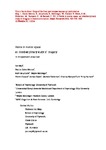Points in mental space: an interdisciplinary study of imagery in movement creation
| dc.contributor.author | May, Jon | |
| dc.contributor.author | Calvo-Merino, B | |
| dc.contributor.author | deLahunta, S | |
| dc.contributor.author | McGregor, W | |
| dc.contributor.author | Cusack, R | |
| dc.contributor.author | Owen, AM | |
| dc.contributor.author | Veldsman, M | |
| dc.contributor.author | Ramponi, C | |
| dc.contributor.author | Barnard, P | |
| dc.date.accessioned | 2012-05-18T17:40:27Z | |
| dc.date.available | 2012-05-18T17:40:27Z | |
| dc.date.issued | 2011 | |
| dc.identifier.issn | 0264-2875 | |
| dc.identifier.issn | 1750-0095 | |
| dc.identifier.uri | http://hdl.handle.net/10026.1/1001 | |
| dc.description.abstract |
<jats:p> As part of a programme of research that is developing tools to enhance choreographic practice, an interdisciplinary team of cognitive scientists, neuroscientists and dance professionals collaborated on two studies examining the mental representations used to support movement creation. We studied choreographer Wayne McGregor's approach to movement creation through tasking, in which he asks dancers to create movement in response to task instructions that require a great deal of mental imagery and decision making. </jats:p><jats:p> In our first experiment, we used experience sampling methods (self-report scales and reports about the current focus of thought) with the full company of Wayne McGregor | Random Dance to describe what the dancers report thinking about while creating movement, and to establish how their experiences change as a function of different task conditions. In particular, we contrasted a conventional ‘active’ condition (where dancers are free to move around) with a ‘static’ condition (where they have to create movement mentally, without moving), because all neuroimaging studies of dance require participants to lie motionless within a scanner. We adapted the static mode from Experiment 1 for the neuroimaging session in Experiment 2. Here we recorded the brain activity of an experienced dancer from Wayne McGregor | Random Dance while she mentally undertook movement creation tasks similar to those used in our experience sampling experiment. Both studies involved imagery tasks of a primarily spatial-praxic nature (involving an imagined object or volume that could be approached and manipulated) and imagery that focused on content invoking emotional narratives. </jats:p><jats:p> In the first study, the dancers’ awareness was focused more than they had anticipated upon conceptual rather than physical or bodily aspects. The very act of reflecting on, and categorising, their experiences provided the dancers with insights about their mental habits during innovative movement creation. Such insights provide conditions under which habits can be recognised and then altered to adopt alternative points in mental space from which to create movement material. Providing the dancers and McGregor with a means to communicate more productively about the properties of the task-based instructions has been acknowledged by the company to be of clear benefit and a useful addition to their working process. </jats:p><jats:p> In the second study we assessed the feasibility of using fMRI to study the neural underpinnings of choreographing movement tasks. The experiment enabled us to compare brain activity in imagery and movement creation. The data raise some key questions concerning the mental context in which such thinking occurs and, given the clear limitations of the current fMRI and experience sampling work, how future research might usefully be directed. </jats:p><jats:p> Taken together, these two exploratory studies indicate that the experiential and neural attributes of imagery during movement creation are open to systematic investigation: innovative movement creation can start from alternative points in mental, as well as physical, space. This enables us to look forward to establishing with greater precision how tasks that challenge dancers in different ways may affect mental and neural processes and how variation in imagery use across dancers might contribute to the variety of movement creation that they produce. Notably, the act of reflecting on the experience of movement creation also offers some practical leverage to help dancers develop a wider range of strategies for innovation. These findings are being used to contribute to further work informing the development of personal, notebook-like, Choreographic Thinking Tools. </jats:p> | |
| dc.format.extent | 404-430 | |
| dc.language | en | |
| dc.language.iso | en | |
| dc.publisher | Edinburgh University Press | |
| dc.subject | Mental Health | |
| dc.subject | Behavioral and Social Science | |
| dc.subject | Basic Behavioral and Social Science | |
| dc.subject | Neurosciences | |
| dc.subject | Mental health | |
| dc.title | Points in mental space: an interdisciplinary study of imagery in movement creation | |
| dc.type | journal-article | |
| dc.type | Article | |
| plymouth.issue | 2 | |
| plymouth.volume | 29 | |
| plymouth.publication-status | Published | |
| plymouth.journal | Dance Research | |
| dc.identifier.doi | 10.3366/drs.2011.0026 | |
| plymouth.organisational-group | /Plymouth | |
| plymouth.organisational-group | /Plymouth/Faculty of Health | |
| plymouth.organisational-group | /Plymouth/Faculty of Health/School of Psychology | |
| plymouth.organisational-group | /Plymouth/REF 2021 Researchers by UoA | |
| plymouth.organisational-group | /Plymouth/REF 2021 Researchers by UoA/UoA04 Psychology, Psychiatry and Neuroscience | |
| plymouth.organisational-group | /Plymouth/REF 2021 Researchers by UoA/UoA04 Psychology, Psychiatry and Neuroscience/UoA04 REF peer reviewers | |
| plymouth.organisational-group | /Plymouth/Research Groups | |
| plymouth.organisational-group | /Plymouth/Research Groups/Centre for Brain, Cognition and Behaviour (CBCB) | |
| plymouth.organisational-group | /Plymouth/Research Groups/Centre for Brain, Cognition and Behaviour (CBCB)/Behaviour | |
| plymouth.organisational-group | /Plymouth/Research Groups/Institute of Health and Community | |
| plymouth.organisational-group | /Plymouth/Users by role | |
| plymouth.organisational-group | /Plymouth/Users by role/Academics | |
| dc.identifier.eissn | 1750-0095 | |
| dc.rights.embargoperiod | Not known | |
| rioxxterms.versionofrecord | 10.3366/drs.2011.0026 | |
| rioxxterms.licenseref.uri | http://www.rioxx.net/licenses/all-rights-reserved | |
| rioxxterms.type | Journal Article/Review |


